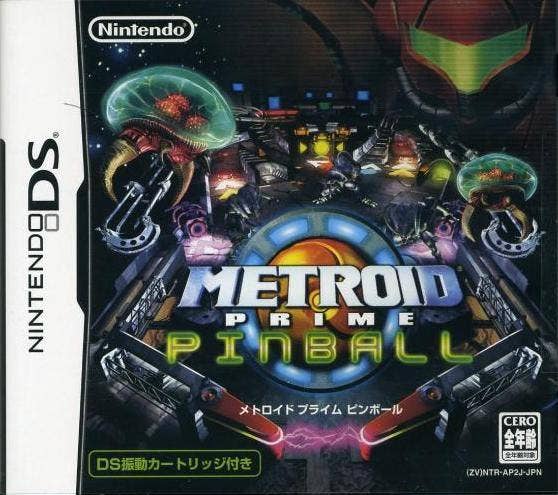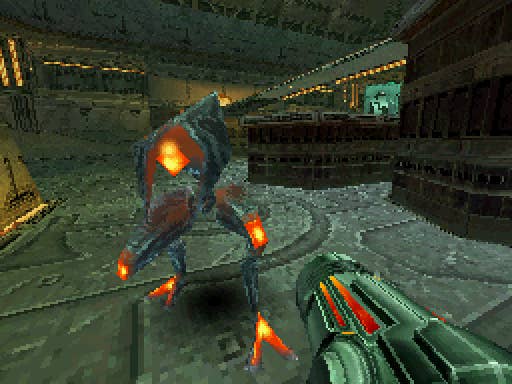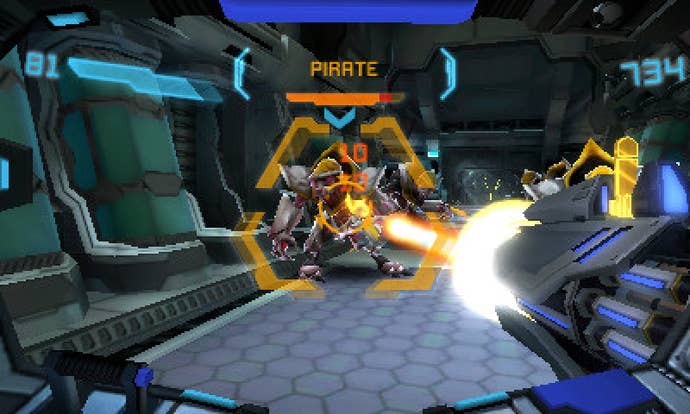Metroid Game-By-Game Reviews: The Metroid Spin-Offs
Samus Aran by moonlight.
This article first appeared on USgamer, a partner publication of VG247. Some content, such as this article, has been migrated to VG247 for posterity after USgamer's closure - but it has not been edited or further vetted by the VG247 team.
While Samus Aran has embarked upon 10 canonical adventures—or eight and two remakes—her career as a bounty hunter has left her a little time for moonlighting. Sometimes she's been an FPS warrior, sometimes an unwitting villain. Once, she was even a pinball. The DS era was weird.
Her three spinoff outings share two elements in common. (No, her ensemble participation in Smash Bros. doesn't count as a Metroid spinoff.) First, they all shipped for portable systems; for whatever reason, Nintendo seemingly decided that despite Samus's first and final chronological adventures (Metroid: Zero Mission and Metroid Fusion) appearing on Game Boy Advance, her handheld exploits in the dual-screen era would be better as oddball one-offs. Things might have been different had Metroid Dread come to fruition, but alas.
Secondly, none of these games turned out to be particularly "good." (Or if anything, not exactly earth-shattering.) In the Nintendo pantheon, Samus steps away from her core competency more like Link (sparingly and somewhat unconvincingly) than, say, Mario or Kirby (prolific, frequently brilliant). You can find something to enjoy in all three of these games, but none of them will force you to reevaluate your feelings about the Metroid franchise or present you with a transformative experience that will redefine your relationship with video games. They're a pretty good time, but none of these holds up to the finest of Samus' canonical journeys.

Metroid Prime Pinball
DS, 2005
Weirdly, the Metroid spinoff that seems least likely to succeed somehow manages to be the most satisfying. Nothing about Metroid Prime Pinball should work. Consider:
- Its developer, Fuse, had only one other credit to its name at the time it published this game: The profoundly disappointing Mario Pinball Land for GBA.
- The pinball game's story mode revolves around the absolute worst part of Metroid Prime: The quest for 12 mystic artifacts.
- The action consists entirely of Samus rolling around in Morph Ball mode, which is typically less a fun game feature than a necessary means to an end.
- It's a pinball game based on Metroid, for crying out loud.
And yet: Metroid Prime Pinball turned out to be good. Somehow, the confluence of these impossible factors resulted in a pretty fun little portable diversion.
Nintendo had a running history of good mascot-based pinball spinoffs by 2005. Mario's misguided attempt aside, its portable systems had given us the likes of Pokémon Pinball and Kirby's Pinball Land. Metroid Prime Pinball adheres to their formula: It takes a spherical element of the canonical games—in this case, Samus' improbable ability to roll into a ball—and reworks familiar in-game scenarios to work with flipper-based pinball mechanics. The best Nintendo pinball titles walk a tightrope between reliance on skill and luck, which can be tricky; pinball involves both, but action games like Metroid should, ideally, come down to skill. Going up against ersatz game situations in pinball form can't be too easy, but it also can't pin too much of the outcome on sheer luck.
Metroid Prime Pinball manages to pull it off, and the proof is in the boss encounters. The game includes two "main" tables and four different tables dedicated specifically to memorable bosses from the real game, including Metroid Prime itself. The sound and visuals perfectly evoke the GameCube hit, and the controls manage to feel precise without offering too much precision. It also offered multiplayer—something else common among and unique to these spinoffs—as well as a variety of entertaining themed minigame events. No one was clamoring for Samus to make her DS debut as a pinball, but in fairness, stranger things have happened in the course of her career.
Rating: 4/5
Simple, but perfectly evocative of Metroid Prime (in pinball form), Metroid Prime Pinball is one of Nintendo's better old-school arcade adaptations of a prized property. It's a little slight in hindsight, with most of the action taking place on two tables. Still, a worthwhile pickup.

Metroid Prime Hunters
DS, 2006
If you want to be technical, Metroid Prime Pinball was truly Samus's DS debut. In fact, she was the very first Nintendo hero to appear on the system; the original "phat" model of the handheld shipped with a demo of Metroid Prime Hunters, First Hunt. This was back in the olden days, before integral system storage, so the demo came on its very own cartridge.
The fact that the DS shipped with at least a slice of a Metroid game on day one paints an exotic image. Not only did Metroid see sequels and spinoffs on a regular basis, Nintendo even held it in high enough regard to use it as a proof-of-concept for their new system.
In hindsight, Hunters seems like a pretty weird way to sell DS, given what the platform would eventually become. The DS broke open the casual games market with genre-busting concepts like Nintendogs and Brain Age, eventually going on to become the second best-selling console in history on the strength of its appeal to non-traditional game players.
Hunters, on the other hand, was effectively the opposite. With it, Nintendo Software Technology attempted to take the genre-busting Metroid Prime and cram it back into the bottle of traditional play. Where Prime played out as a methodical exploratory adventure game that happened to unfold through first-person gunplay, Hunters saw Nintendo attempting to turn it into precisely the sort of fast-paced multiplayer combat shooter that everyone envisioned with dread the moment they announced Prime as an FPS. If Prime was Nintendo's Half-Life, Hunters wanted to be its Quake III.
It didn't entirely succeed at this nefarious plan, in large part due to the limitations of the platform. The DS, with power and performance hovering somewhere in the neighborhood of Nintendo 64 and the original PlayStation, didn't really offer the resolution or speed to provide a fully convincing death match shooter.

And then there was the matter of the interface. The DS didn't have an analog controller, but rather shipped with a simple D-pad. It did, however, include a touch panel on its lower screen. Nintendo really wanted to sell the touch screen as an alternative analog interface device… which worked fine for the likes of Animal Crossing: Wild World and The Legend of Zelda: Phantom Hourglass. When it came to high-speed action, however, the touch panel lacked a certain something. The original DS model included a strange thumbstrap that players could stick on their opposable digit to transform the finger/screen pairing into a sort of hybrid of analogue stick and stylus.
In practice, it turned out to be kind of terrible. The full version of Hunters didn't ship for a year and a half into the system's life, presumably as NST struggled to elevate the final game over the spotty First Hunt demo. And in fairness, Hunters was probably about as good as the touch-screen-as-thumbstick mechanic ever got; the game does move at a decent clip, and you have pretty respectable control over Samus' aim. But there's a reason you didn't see this interface approach much after Hunters, and a reason Nintendo stopped shipping systems with the thumb strap.
Hunters turned out to be competent, even bordering on reasonably entertaining, but it feels superfluous. I mean that in two ways, really: in terms of the Metroid canon, for one. It places a heavy emphasis on rival bounty hunters like Sylux, who Prime producer Kensuke Tanabe really wanted to turn into a breakout star, rather than further Samus' own tale in a meaningful way. And it's superfluous to the platform, as a failed excursion into the competitive arena shooter space… something Nintendo never managed to pull off until Splatoon. Hunters is definitely one of the franchise's more forgettable moments.
Rating: 2.5/5
More an experiment and a proof-of-concept than a proper game. But on the plus side, at least it turned out better than that lousy multiplayer mode in Echoes.

Metroid Prime: Federation Force
3DS, 2016
The Metroid series lay abandoned for six years in the wake of Other M's critical, commercial, and fandom belly-flop. After a while, you couldn't help shake the sensation that Nintendo had abandoned it altogether. We hadn't seen a single blip of Metroid on 3DS or Wii U, outside of the obligatory performances on Virtual Console and Smash Bros.
That, I'm sure, is why the series' return after more than half a decade of silence went over like a MAGA cap at the Castro Street Fair. Metroid fans didn't simply avoid Metroid Prime: Federation Force, they responded to it as if it had personally claimed responsibility for the existence of cancer. From the online response to Federation Force, you could be forgiven for thinking Nintendo had just announced that its new corporate policy would be to travel to every home in America and personally destroy all existing copies of previous Metroid games.
In reality, Federation Force turned out to be a perfectly pleasant little game, by far the best multiplayer adaptation of the Metroid concept seen to date. But Federation Force, without question, was a case of the wrong game at the wrong time. With the wrong graphical style. On the wrong platform. In the wrong genre, with the wrong storyline. In short, circumstance doomed Federation Force.
Divorced of context, however, Federation Force offers a great deal to like. It takes the bold step of putting players at a remove from Samus Aran, something that no other Metroid game besides Hunter had attempted. Rather, you play as one of the generic Federation soldiers whose bodies you inevitably find strewn about the caverns of SR-388 or Zebes. To boost your survivability, you rely on two tactics. First, most of your adventuring is done in a heavy suit of mechanical armor, which greatly improves your defenses and power. You can duck out of your armor, but you're hopelessly underpowered when you do so.

Secondly, and more essentially, you rely on your squad for support. Federation Force can technically be played solo, but in practice that works out to be effectively impossible. The game doesn't scale to accommodate the number of active players, and after the first half-dozen or so missions you begin to encounter scenarios in which your lone space marine can't hope to survive on their own. Right around the mission where you need to escort mine carts through constantly cycling electrical storms while under attack by space pirates is the point at which Federation Force asserts itself as a multiplayer game.
Which is a shame, because good luck finding anyone else who wants to play it with you. Between its online reputation and bobble-head baby art style, Federation Force amounts to a bit of a poison pill among Metroid fans. Now that we have Samus Returns and news of an upcoming fourth entry in the Prime series, it's easier to see Federation Force as the first wave in a resurgence of the Metroid franchise. But it's far too late to rehabilitate its reputation, and the game's refusal to present a reasonably balanced challenge for a single player really hurts its longevity. The ridiculous final battle really sort of seals the deal. Sorry, Federation Force. This world was stacked against you from start to finish.
Rating: 3.5/5
A pretty entertaining side story to the Metroid universe, Federation Force is actually quite a lot of fun with a few friends and the ability to set aside your preconceptions about what a Metroid game should be. It probably would have fared a whole lot better if it had come out after Samus Returns, though. As the vanguard of a new era for Metroid, it feels like a terrible misreading of the series' fan base.
